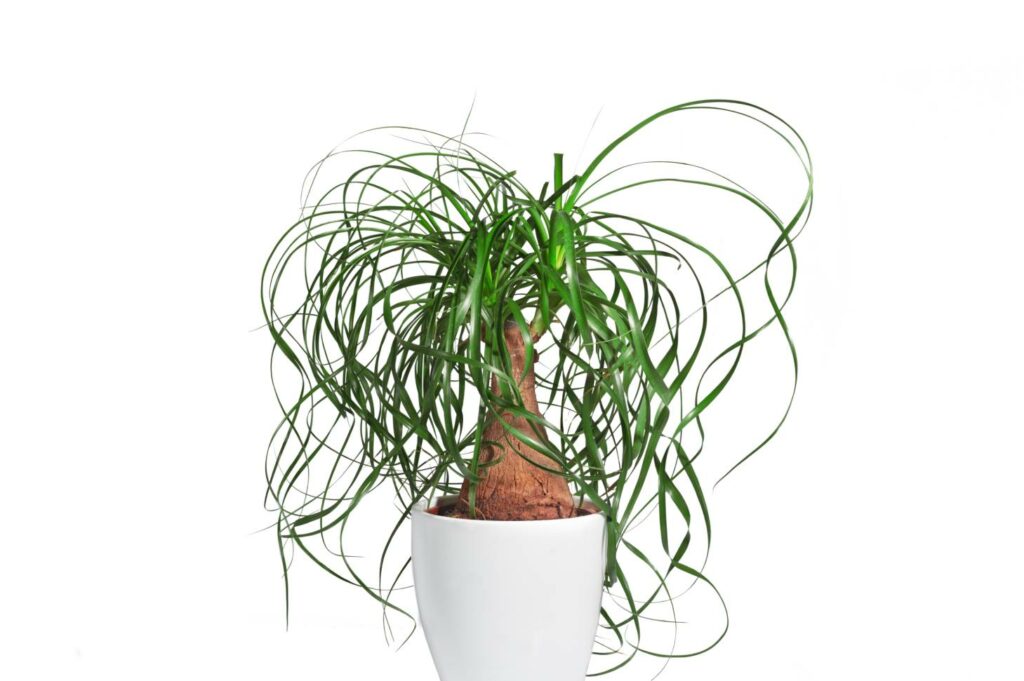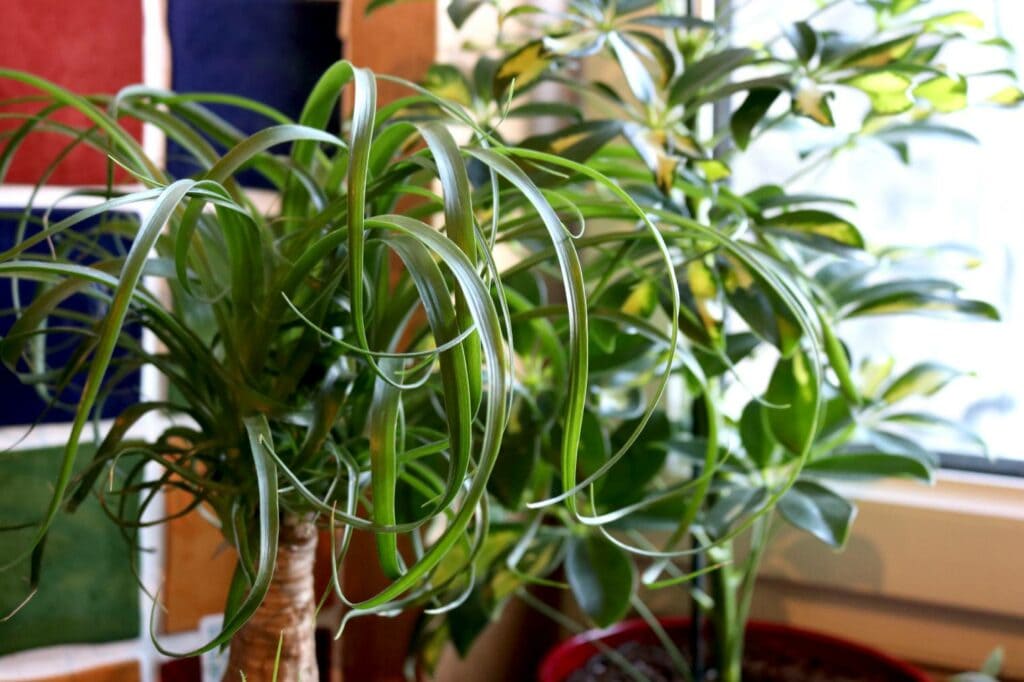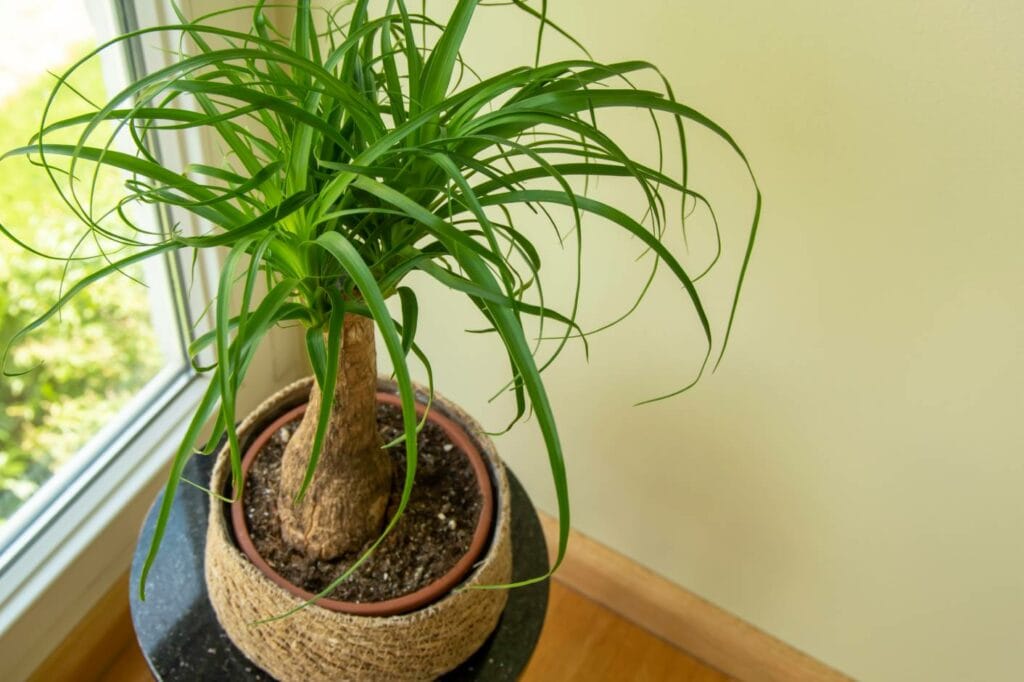How Much & How Often to Water Ponytail Palm: Steps, Facts, & FAQ
-
Greg Iacono
- Last updated:

The ponytail palm is a unique plant with long, slender leaves and a large, bulbous root base. Amazingly, the leathery leaves of this unique succulent plant can grow to 3 feet in length indoors and up to 6 feet outdoors. They’re both attractive and impressive if you’ve ever seen a very large ponytail palm in person. Plus, although it looks like a palm tree, the ponytail palm is more closely related to agave, yucca, and other desert succulents.
If you’ve just purchased your first ponytail palm, you’ll be glad to know it’s an exceptionally easy plant to grow indoors. As for watering a ponytail palm, experts recommend about once every 2 to 3 weeks, but only when the soil is very dry. Also, misting once a week between watering will keep your ponytail palm cleaner.
As for how much to water a ponytail palm, that depends on its size and location. The plant’s roots need to be soaked but then dry out thoroughly, so every ponytail palm will need different care. The good news is that the plants are hard to kill, as long as you don’t overwater them. To learn more about the fascinating plant, including how to water it (it’s a process), read on!
How To Water a Ponytail Palm
Watering a ponytail palm isn’t difficult but does take a little effort and time. You need to ensure the plant’s root bulb doesn’t stay soaked between waterings as it will begin to rot. To do that, you need to water the ponytail palm by soaking it (in its pot) in a water container. Below are the steps to water your ponytail palm.
- Grab a clean plastic dish tub. You can also use a sink, but it will be filled with water for 45 minutes.
- If you use a dish tub, fill it with 3 or 4 inches of water. Do the same in your sink if you use it. Room temperature water is best.
- Grab your ponytail palm and place it in the water without the bottom plate.
- Let your ponytail palm sit for 45 minutes, soaking up water in its roots.
- Remove your plant and place it where excess water can drain freely.
- Put your ponytail palm back in its regular spot. It should be sunny and well-ventilated.

How To Know When to Water a Ponytail Palm
When you see a ponytail palm, the large, bulbous root ball (called a cadeaux) can remind you of an elephant’s foot. However, the plant is more like a camel as the root bulb holds water like a hump. For this reason, the best time to water a ponytail palm is when its soil is very dry. The top 2 inches at least should be dry to the touch. If you repeatedly water your ponytail palm when the soil is already wet, the root bulb will rot and kill the plant. Experts recommend erring on the side of caution and watering your ponytail palm less rather than more.
If you have a large, outdoor ponytail palm, soaking it will be out of the question. Instead, you’ll need to give it enough water to soak its soil thoroughly and then let the soil dry just as thoroughly before you water it again. Ponytail palms can reach heights of 30 feet outside, and when they do, their bulb grows to a massive size!
Do Ponytail Palms Need Full Sunshine?
Although indoor ponytail palms need plenty of bright light, they don’t need direct sunlight as much. For that reason, you should put them as close to a window as possible but out of direct sunlight for most of the day. They can handle 2 or 3 hours of direct sun. As most homes and apartments are rather dry, a small ponytail palm should thrive with lots of light and a little water.

Can Ponytail Palms Go Outside in Summer?
Ponytail palms thrive in hot, arid areas like Arizona, New Mexico, Nevada, and Mexico. Putting your ponytail palm(s) outside during summer is a fantastic idea. However, don’t put them where they will be in direct sunlight for more than an hour or two per day. Indoor plants can burn easily outside without protection from the sun’s rays.
What Are the Best Conditions for a Ponytail Palm?
The best overall conditions for a ponytail palm are dry, hot, and slightly windy. A very well-lit area is best indoors, near a window or door that lets in fresh air regularly. Outside, larger ponytail palms can take the sun’s full heat without a problem, but their soil should be loose and well-draining.

Do Ponytail Palms Grow Quickly?
Ponytail palms are very slow-growing plants. They grow an average of 4 to 12 inches or less each year and can take up to 5 years to reach only 2 feet in height. That’s why ponytail palms are usually sold when they are only 12 to 14 inches high, as a 4-foot plant would cost between $200 and $400! The longer it takes to grow, the higher the price due to watering, care, and feeding costs.
How Often Does a Ponytail Palm Bloom?
If you have a large, mature ponytail palm in your yard, you probably know that it blooms two or three times a year. When in bloom, the outdoor ponytail palm will show long clusters of flowers called an inflorescence. The blooms shoot up from the plant’s apex, similar to feathers in a headdress.
Indoor ponytail palms, on the other hand, rarely bloom unless they’re quite large and very mature. By that time, they will likely have grown too large for your home and will have been moved outdoors. Under most circumstances, you will have to wait 10 years or more for that to happen. However, once a ponytail palm has bloomed for the first time, it will bloom every year afterward. What’s fascinating is that experts don’t know what exactly causes the ponytail plant to bloom for the first time. They believe a combination of factors, including heat, humidity, size, and age, are responsible but aren’t sure of the exact combination.

When Should You Repot a Ponytail Palm?
One thing to consider about ponytail palms is that, unlike many plants, they thrive when root-bound. For that reason, moving them to a bigger pot isn’t always helpful and, in some cases, can harm the plant. Also, if you’re growing your ponytail palm to be a bonsai plant, keeping it in its small pot is a better choice. When moved into a bigger pot, the first thing a ponytail palm will do is grow to fit inside the pot snugly. That’s the exact opposite of what you want for a bonsai plant.
How Big Do Ponytail Palms Get Indoors?
A ponytail palm will only grow as big as its pot. If you keep it in a smaller pot, it will stay small. They like being root bound, so there’s not as much need to repot them as other plants. In short, you can keep them as small as you like, or repot them and watch them grow!
Final Thoughts
How much and how often do you need to water ponytail palms? As we’ve seen today, you should water them thoroughly as often as needed but let their soil dry completely between watering. Ponytail palms love any size container and will grow to fit whichever size you use. Also, the roots hold water like a sponge and can go for long periods without being watered. Best of all, ponytail palms are one of the easiest indoor plants to own.
The ponytail palm is a beautiful plant and worthwhile, easy-to-care-for addition to any collection of indoor plants. Plus, their stark beauty and interesting name are a real conversation starter!
- https://greeneryunlimited.co/blogs/plant-care/ponytail-palm-care#:~:text=You%20won’t%20need%20to,any%20moisture%20in%20the%20soil.
- https://bloomscape.com/common-issue/how-do-i-know-when-to-water-my-ponytail-palm/
- https://plantscraze.com/water-ponytail-palm/
- https://www.almanac.com/plant/ponytail-palms#:
- https://www.gardeningknowhow.com/houseplants/ponytail-palm/ponytail-palm-flower.htm
- https://www.bhg.com/gardening/plant-dictionary/houseplant/ponytail-palm/#:
Featured Image Credit: SzB, Shutterstock
Contents
